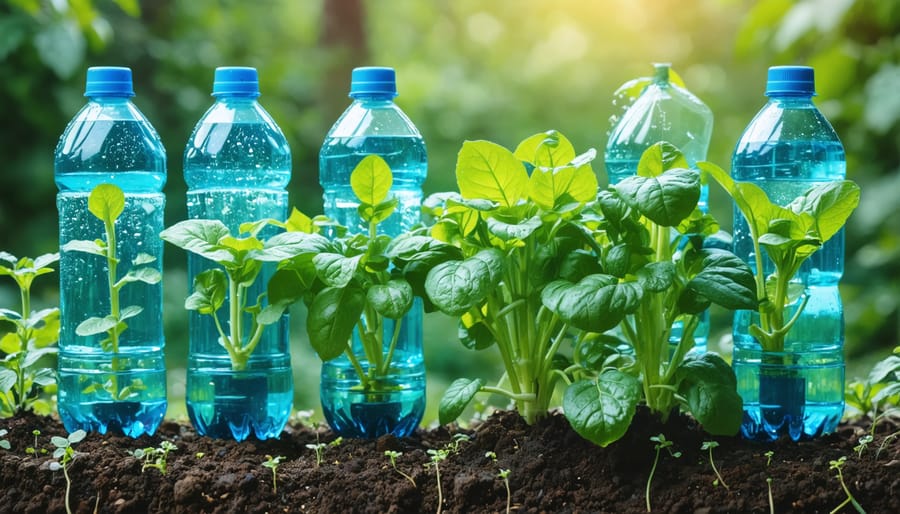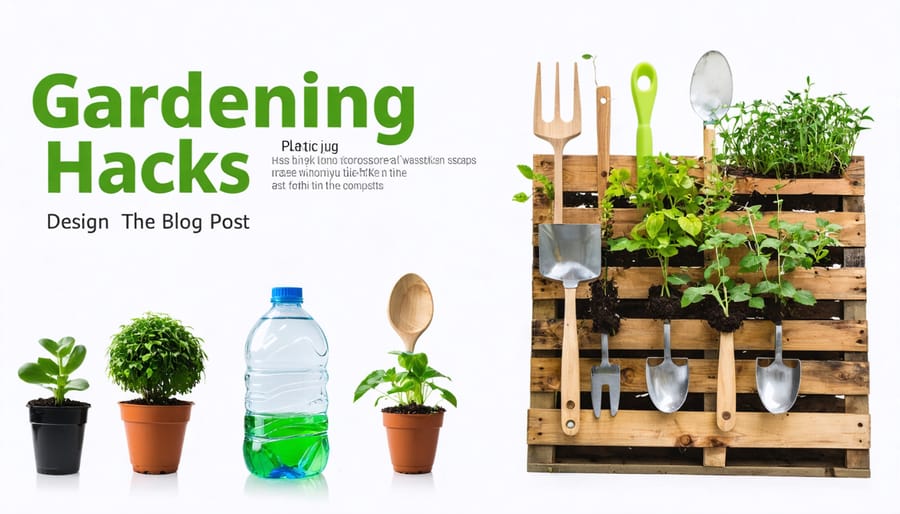Transform empty plastic milk jugs into self-watering planters by cutting drainage holes and filling them with potting mix – perfect for growing herbs and small vegetables in limited spaces. Mix crushed eggshells directly into planting holes to prevent blossom end rot and boost calcium levels naturally. Repurpose old pallets into vertical garden walls by sanding rough edges, lining with landscape fabric, and securing them firmly to sturdy surfaces. While these DIY solutions can revolutionize your garden setup, be sure to avoid common gardening mistakes to avoid that could compromise your plants’ health. Create organic pest deterrent by steeping crushed garlic and hot peppers in water for 24 hours, then spraying directly on affected plants. Install recycled wine bottles upside-down in soil near deep-rooted plants for consistent, slow-release watering during dry spells.
Smart Soil Solutions That Actually Work
Kitchen Scraps to Garden Gold
Transform your kitchen waste into gardening gold with these smart composting shortcuts. Start by collecting coffee grounds, eggshells, and vegetable scraps in a countertop compost bin for easy access. Speed up decomposition by chopping food waste into smaller pieces before adding it to your pile. Create a “compost tea” by steeping banana peels in water for 48 hours – this nutrient-rich liquid works wonders for plant growth.
Don’t toss those citrus peels! Dry and grind them to create a natural pest deterrent. Used tea bags can be placed directly around plants to slowly release nutrients, while coffee grounds make an excellent addition to soil for acid-loving plants like tomatoes and blueberries.
For apartment dwellers, try vermicomposting with red wiggler worms in a compact bin system. These efficient decomposers turn kitchen scraps into rich castings within weeks. Remember to maintain a balance of green materials (food scraps) and brown materials (dried leaves, paper) for optimal decomposition.
Keep a spray bottle of diluted cooking water from vegetables to give plants an extra nutrient boost. This zero-waste approach helps create a sustainable garden while reducing kitchen waste.

No-Till Gardening Shortcuts
No-till gardening is a game-changer for busy gardeners who want to maintain healthy soil without the backbreaking work of traditional tilling. Instead of disrupting soil structure, simply layer organic materials directly on top of your existing soil. Start with a thick layer of cardboard or newspaper to suppress weeds, then add alternating layers of compost, leaves, and grass clippings.
For new garden beds, use the “lasagna gardening” method: layer green materials (kitchen scraps, fresh grass clippings) with brown materials (dried leaves, straw) directly over your lawn. Within a few months, you’ll have rich, plantable soil without ever lifting a shovel.
To plant in a no-till bed, simply pull back the mulch layer and create small planting pockets. The undisturbed soil beneath maintains its natural structure, beneficial microorganisms, and earthworm populations. This method not only saves time and energy but also helps retain soil moisture and reduces weed growth.
Keep your no-till garden thriving by adding fresh layers of compost and mulch each season, letting nature do the hard work for you.
Water-Wise Garden Tricks
Self-Watering Solutions
Creating your own self-watering system doesn’t require expensive equipment – just a bit of creativity and some recyclable materials from around your home. While understanding the best water for plants is important, ensuring consistent delivery is equally crucial for healthy growth.
One simple solution involves using plastic bottles as water reservoirs. Cut the bottom off a clean 2-liter bottle, drill small holes in the cap, and bury it cap-down next to your plants. Fill the exposed end with water, and it will slowly seep into the soil as needed.
For container gardens, try the wick method. Thread a piece of cotton rope or fabric strip through the drainage hole of your pot, leaving one end in the soil and the other in a water reservoir below. The wick draws water up to your plants through capillary action.
Old wine bottles make excellent slow-release waterers. Simply fill them with water and quickly flip them into pre-made holes in your garden soil. They’ll gradually release water as the soil dries out.
For raised beds, create a simple irrigation system using PVC pipes with drilled holes. Connect them to a rain barrel for an eco-friendly watering solution that works while you’re away.

Moisture-Retention Magic
Keeping your garden hydrated doesn’t have to drain your water bill or your energy. Try layering different organic materials for a moisture-retaining mulch that works like magic. Start with a layer of cardboard or newspaper as a base, then add straw, leaves, or grass clippings. This multi-layer approach creates a natural moisture barrier that keeps your soil damp for longer periods.
Coffee grounds aren’t just for your morning brew – they’re excellent moisture retainers! Spread used grounds around your plants to help retain water and add nutrients to the soil. For container gardens, try mixing water-absorbing crystals or hydrogels into your potting mix. These tiny powerhouses can hold up to 500 times their weight in water.
Here’s a clever trick: bury unglazed terra cotta pots near your thirsty plants. Fill these pots with water, and they’ll slowly release moisture into the surrounding soil. Wine bottles can serve a similar purpose – just flip them upside down in the soil after filling them with water.
For raised beds, consider adding a layer of rocks or gravel at the bottom before filling with soil. This creates a natural reservoir that helps regulate moisture levels. Remember to water deeply but less frequently to encourage deeper root growth and better drought resistance.
Plant Protection Made Easy
DIY Pest Deterrents
Keep unwanted garden visitors at bay with these eco-friendly natural pest control methods using common household items. Create a powerful deterrent spray by steeping crushed garlic and hot peppers in water for 24 hours, then spraying it around plant bases to repel various insects and small mammals.
Coffee grounds aren’t just for your morning brew – scatter them around your plants to deter slugs and snails while adding nutrients to your soil. For aphid control, mix one tablespoon of dish soap with a quart of water and spray affected plants. The solution breaks down the insects’ protective coating without harming your vegetables.
Plant companion flowers like marigolds and nasturtiums throughout your garden – they naturally repel harmful insects while attracting beneficial pollinators. Create protective barriers using eggshells around tender seedlings to prevent slug damage and add calcium to your soil as they decompose.
For larger pests, try placing reflective items like old CDs or aluminum pie plates near your plants – the light reflection confuses birds and other creatures. A simple mixture of vinegar and water sprayed around garden borders helps keep four-legged visitors away while being safe for your plants.
Remember to reapply these natural solutions after rain and rotate different methods to prevent pests from becoming resistant to any single approach.
Weather Protection Tricks
Protecting your garden from unpredictable weather doesn’t have to be complicated or expensive. One of the simplest tricks is using plastic milk jugs as mini greenhouses – just cut off the bottom, remove the cap, and place them over tender seedlings to shield them from frost and harsh winds.
For larger plants, create instant protection using old bed sheets or lightweight blankets draped over garden stakes or hoops. This temporary coverage works wonders during unexpected cold snaps. Remember to remove the covers during the day to prevent overheating.
Empty plastic soda bottles make excellent plant protectors too. Cut them in half and use the bottom portion as a cloche to protect young plants. The top half can be inverted and stuck into the soil around plants to create a self-watering system during hot spells.
During intense summer heat, use old window screens or shade cloth suspended above plants to provide filtered sunlight. For container gardens, group pots together to create a microclimate that helps retain moisture and protect roots from temperature extremes.
Don’t forget about mulching – a thick layer of straw, leaves, or grass clippings helps regulate soil temperature and moisture levels year-round. For raised beds, attach PVC pipes in hoops and cover with clear plastic to create instant cold frames or rain shelters when needed.
These simple solutions use everyday items to keep your garden thriving through challenging weather conditions while maintaining organic growing practices.
Time-Saving Tools and Techniques
Transform everyday household items into clever gardening solutions with these time-saving tricks. Old plastic milk jugs make perfect watering cans – just punch small holes in the cap and fill with water. Keep your tools organized by mounting an old wooden pallet on your shed wall, creating instant storage slots for rakes, shovels, and other long-handled equipment.
Save time on weeding by laying down newspaper or cardboard as a natural weed barrier before adding mulch. This biodegradable solution keeps weeds at bay while enriching your soil as it decomposes. Turn plastic containers into self-watering planters by cutting small drainage holes near the bottom and adding a water reservoir.
Create instant plant markers using plastic spoons – write plant names with permanent marker on the bowl of the spoon and stick the handle into the soil. For seed starting, empty toilet paper rolls make excellent biodegradable starter pots that can be planted directly into the ground.
Old window blinds cut into strips make perfect plant labels, while wine corks stuck on bamboo skewers create charming garden markers. Use a rubber-coated wire hanger bent into a circle as a flexible plant support for climbing vegetables. For precise seed spacing, create a planting template from cardboard with properly spaced holes – just lay it down and drop seeds through.
These simple hacks not only save money but also reduce waste by repurposing items you already have at home.

These DIY gardening hacks prove that you don’t need expensive equipment or years of experience to create a thriving garden. By repurposing everyday items and embracing natural solutions, you can solve common gardening challenges while staying eco-friendly and budget-conscious. Whether you’re using eggshells for pest control, creating self-watering systems from plastic bottles, or turning kitchen scraps into nutrient-rich compost, these creative solutions make gardening more accessible and enjoyable. Remember, sustainable gardening is about working smarter, not harder. Start with one or two of these hacks and gradually incorporate more as you become comfortable. Your garden – and the environment – will thank you for choosing these natural, cost-effective approaches to growing your own food and beautiful plants.

